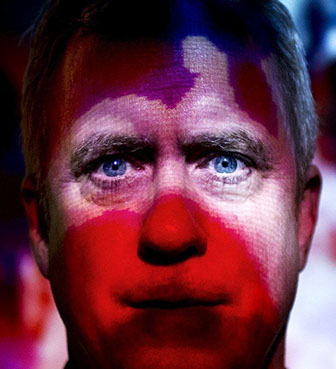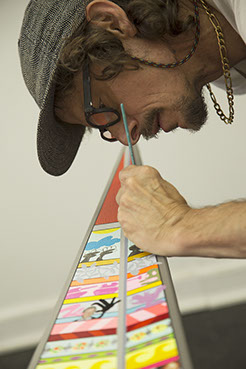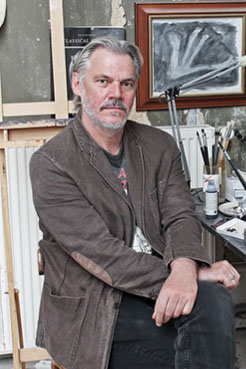Khora Contemporary
Tony Oursler
Spacemen R My Friended
2016
The work by Tony Oursler is an exploration of a person’s mind and story. The viewer is invited to follow George Adamski, a ‘contactee’, claiming himself to be the first person ever to have seen and talked to aliens and even visited other planets.
Tony Oursler has always been investigating and using contemporary technology both in his art and as a source of inspiration. The Virtual Reality artwork therefore lies as a natural extension to his pratice. space men r My friend, arises from the path Oursler took with Imponderable and the Imponderable Archive shown at MoMA and Hessel Museum of Art at Bard College, NY, and explores the interlinking characters involved with the origins of Unidentified Flying Object photography.
The main character in the Virtual Reality Artwork, space men r My friended, is a first generation Polish immigrant and one of the leading UFO figures, who arguably is the first UFO photographer. In the 1930s George Adamski made small fortune by winemaking during Prohibition with a government license. At the end of the prohibition, Adamski lost his profitable earnings and with his wife Mary Shimbersky and some close friends, moved to a ranch near California’s Palomar Mountain, where they dedicated their time to studying religion, philosophy, and farming. It was in this area that Adamski first saw a large cigar-shaped ‘mothership’ in 1946. In 1947 Adamski managed to take a photograph of the ship, and in 1950 – after seeing several UFOs over the years – he took a photograph of what he alleged to be six UFOs in the sky. Two years after Adamski and his friends observed another submarine-shaped object in the sky in the Colorado Desert, from which a scout ship disembarked, Adamski was contacted by the Venusian pilot called Orthon. After his first encounter with UFOs Adamski began to give lectures about his experiences and paranormal activities.
Erik Parker
Switchstance Bay
2016
Erik Parker is known for his colourful palette and twisted motifs, that draw inspiration from a variety of elements; from American subculture, comic books and hip hop to a heavy art-historical tradition of among others Pablo Picasso, Francis Bacon and Roy Lichtenstein. His acrylic paintings consist of chaos and fragmentation perfectly balanced in a jumble of colour.
Switchstance Bay unfolds Parker’s tropical universe from 2014; Foreign Resistance, previously only seen on a two-dimensional surface. When entering the Virtual Reality the participants find themselves at first sight in a lush surrounding with popping and unnatural colours – an artificial paradise created by Parker’s imagination.
However, the scene quickly turns into a dystopia while realizing that what one sees might be the prospects and consequences of climate changes and environmental problems. The purple water, the psychedelic colour of the trees, their leaves and the flowers and the unreal shadows make you wonder if this is a sight of a strange utopia or a dystopia. The old school dub and slash key music, that changes every time you pass through the doorway of the cave to arrive at the shore, underlines the uncanny of the atmosphere. Regardless of how you feel about the setting though, it is undoubtedly a fascinating pioneering virtual reality.
Christian Lemmerz
La Apparizione
2017
Christian Lemmerz’s La Apparizione, produced earlier in 2017, aims to disrupt stereotypes of religious imagery, engaging the viewer in a discomforting, close-up experience with a burning corpse of Jesus Christ, which ‘rains’ embers. Jesus and other religious personages have figured in the artist’s work before, and ‘Bodybuilder’ Jesus first appeared in Lemmerz’s oeuvre in 2013 in sculpture form. Here, he comes alive in death, his rippling muscles writhing in agony, dripping golden blood into the physical space of the viewer. The aim of this VR work is to enhance the relationship the viewer forms with the imagery; its beauty, excess, death and pain.
La Apparizione was shown within Biennale Arte 2017 – 57th International Art Exhibitionat the Fondazione Cini as part of the summer’s Faurschou Foundation presentation in Venice.

Christian Lemmerz
TRAUM
2018
Christian Lemmerz’s second VR work TRAUM materialises the tragic as a virtual space, using the aesthetics of hyper realistic video games to create a Freudian nightmare. Users find themselves in a steel cell, that flits from total smoke-filled darkness to dim illumination. Snakes slowly slither into the space, multiplying in number as they turn on the viewer. Fear, helplessness and vulnerability materialise as a paralysing force that echoes the oppressive, prison-like surroundings. The medium offers agency only to strip it away, creating feelings of entrapment and mounting claustrophobia.
TRAUM premiered in September 2018 at Techfestival in Copenhagen, Denmark.
Christian Lemmerz
Locus Solus
2020
Locus Solus is the third and final part of Christian Lemmerz’s Virtual Reality trilogy, which visualises various mental states. La Apparizione, 2017 was about the religious vision, TRAUM, 2018 was a concentrated nightmare and Locus Solus combines hypnosis with the idea of death.
Lemmerz considers working with Virtual Reality as the opportunity to work as a strong illusionist. He consciously works with elements from video games, comic books and kitsch. It is an expression that seeks to seduce directly and unscrupulously, but at the same time invites a cultural reflection on the reality of consciousness.
In Locus Solus, the spectator stands in an infinite space (black or white, not settled yet). Around the body thousands of skulls orbit their own axis circle like planets. A seductive voice describes and guides the viewer through this universe of death. At the end of the monologue, there is a countdown that should lead to cardiac arrest.




